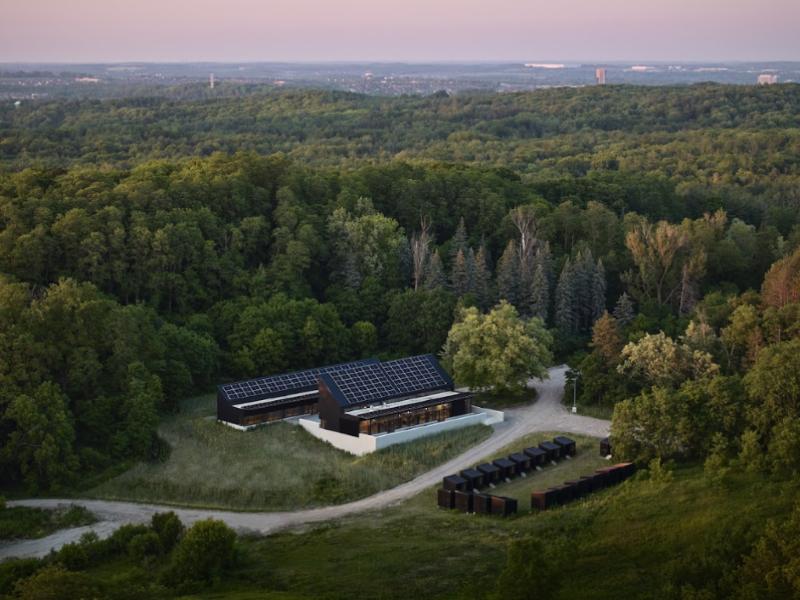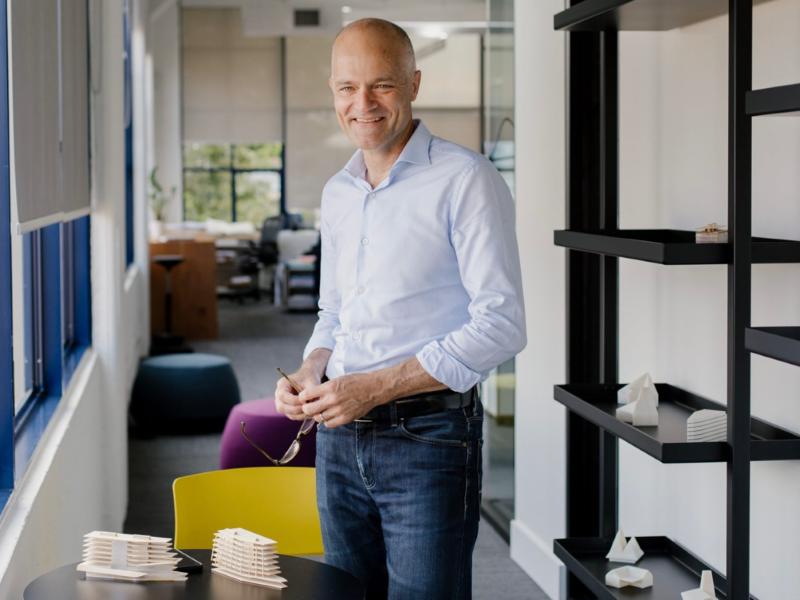
The University of Toronto’s Koffler Scientific Reserve proves buildings can be beautiful without sacrificing sustainability, Robert Davies, the lead architect behind the project, said in an interview with Sustainable Biz Canada.
A 28,860-square-foot facility built in King City, north of Toronto in the Oak Ridges Moraine, it sits on a forested property donated to the university in 1995 by Murray and Marvelle Koffler — Murray Koffler was the founder of Shoppers Drug Mart — for conservation and research.
With much of the research based in the facility to revolve around how the natural world will react to a warming climate and human activity, it was critical to minimize its impact on the local environment, John Stinchcombe, an ecological genetics professor and director of the reserve, said in an interview.
The facility will feature renewable energy generation and architecture enabling passive heating and cooling. To reduce carbon emissions from the building materials, low embodied carbon options were selected.
To Davies, a principal at Toronto-based Montgomery Sisam Architects, the project is a demonstration of how “you don’t have to be uber-sophisticated” to design a sustainable building. “You can do it in a lot of simple ways.”
Passive design, renewables, mass timber
Nestled in a clearing surrounded by trees, the Koffler Scientific Reserve will consist of a main building and 20 bunkie cabins that can house three people each to accommodate students during the peak research seasons.
The reserve will have what is expected of a typical university campus: classrooms, a dining hall, commons rooms, a cloister and a quad.
Montgomery Sisam Architects arranged the main building to optimize heating in desired areas via the sun during the winter, and keep sunlight out during the summer to reduce cooling demand.
For passive cooling, the main building was designed to draw in chilled air during the summer. As an additional source of low-carbon heating and cooling, an earth tube is being installed around the perimeter of the reserve. A vertical geothermal system will be on site to serve as a thermal battery, preheating or precooling the building’s radiant heating and cooling system.
Arrays of solar panels on the roof of the main building and the roofs of the bunkies will provide 75 megawatt-hours of renewable energy to the facility per year.
In an effort to minimize the embodied carbon of the facility, it was built with mass timber, wood cladding and rockwool insulation.
Montgomery Sisam Architects began drawing the schematics of the Koffler Scientific Reserve in 2017. Construction began five years later, with first occupancy expected in the spring of 2026.
The facility is being built to target net-zero carbon, net-zero energy performance and LEED Gold. Attaining these targets and the standard “was a very important ambition to have, and we’ve been able to achieve it,” Davies said.
The University of Toronto has embarked on initiatives to shrink the environmental impact of its campuses and buildings, such as investing in deep energy retrofits for its St. George campus. Its has a goal of making its three campuses absorb a net amount of greenhouse gas emissions by 2050.
Additionally, earlier this month the University of Toronto was ranked second in world for sustainability in the QS World University Rankings.
A research area for people who will be outdoors
The area surrounding the reserve teems with hundreds of plant and animal species living in its forests, wetlands, rivers, lakes, bogs and prairies, such as sugar maples, the Canada lily, deer and bald eagles. Its geographic and ecological diversity make it an excellent place for hands-on outdoors research and learning about ecology, evolutionary biology and environmental science.
Researchers and students will be able to study “how organisms and ecosystems are going to respond to global change,” and “the basic ecology and evolution of how species and ecosystems work,” Stinchcombe said.
For example, there will be experimental ponds with adjustable temperatures to simulate a cooling or warming environment, supporting studies on how different temperatures will affect species interactions.
There is no building quite like the Koffler Scientific Reserve in the University of Toronto’s portfolio, Stinchcombe believes. “I’m pretty sure on environmental and (sustainable) construction, it’s unique in the U of T ecosystem.”
The reserve will be a place for “people who are spending their days in and out, mainly outdoors,” he said. Its glass windows will offer a view into the forests and rolling hills, and the transition from the indoors to the outdoors will be “pretty seamless,” Stinchcombe added, immersing its occupants in nature.










